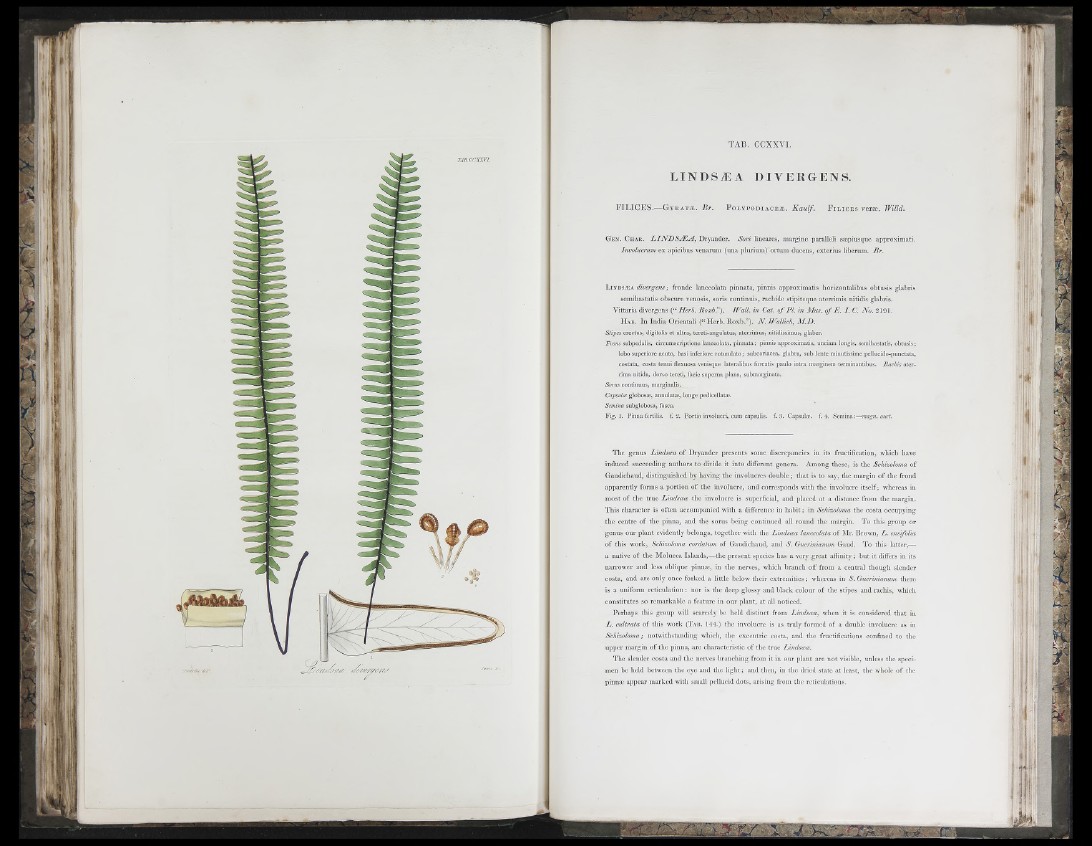
TAB. CCXXVl.
L I N D SÆ A D I V E R G E N S .
FILIC ES .— G y r a t j e . B r . P o l y p o d i a c e æ . K a u lf . P i l i c e s ve ræ. Willd.
Gen. Char. L I N D S Æ A , Dryander. S o r t lineares, margine paralleli sæpiusque approximati
Involucrum e x apicibus venarum (una plurium) ortum ducens, extcrius liberum. B r .
L in d sæ a d ive rg en s; fronde lanceolata pinnata, pinnis approximatis horizontalibus obtnsis glabri;
semihastatis obscure v en o sis, soris continui«, rachide stipiteque aterrimis nitidis glabri
Vittaria divergens (“ Hei-h. Roxb."). IF a ll. in Cal. o f P I. in M u s . o f E . I . C. N o . 2 191.
H ab. In India Orientali (“ Hcrb. Roxb.”) . N . TFallich, M .D .
S tip e s erectus, digitalis et ultra, tereti-angulatus, aterrimus, nitidissimus, glaber.
F ro n s subpedaiis, circumscriptione lanceolata, pinnata ; pinnis approximatis, unciam longis, semihastatis, obtusis ;
lob o superiore acuto, basi inferiore rotundato; subcoriacea, glabra, sub lente minutissime pellucido-piinctata,
costata, costa tenui flexuosa venisque lateralibus furcatis paulo intra marginem terminantibus. R a ch is ater-
nitida, dorso teveti, facie superna plana, subinarginata.
Sorus continuus, margiualis.
Capsuloe g lobosoe, aiinulatoe, lon ge pedicellatæ.
S emin a subglobosa, fusca.
;. 1. Pinna fertilis. f . 2 . Portio involucri, cum capsulis. f. 3 . Capsulæ. f . 4 . Semina:— magn. aiict.
T h e genus L indsæa o f Dryandcr presents some discrepancies in its fructification, which have
induced succeeding authors to divide it in to diflerent genera. A m o n g th ese , is th e Sc/iizoloma o f
Gaudicliaud, distinguished by having th e involucres double ; that is to say, the margin o f the frond
apparently forms a portion o f the involucre, and corresponds with th e involucre itse lf; whereas iu
m o st o f th e true Lindsoeæ the involucre is superficial, and placed at a distance from the margin.
This character is often accompanied with a difference in hab it; in Schizoloma the costa occupying
the centre o f the pinna, and the sorus being continncd all round the imlrgin. To this group or
genus our plant evidently belongs, to g e th er with the L in d sæ a lanceolata o f Mr. Brown, L . ensifolia
o f this work, Schizoloma cordatum o f Gaudicliaud, and S . Guerinianum Gaud. T o this latter,—
a native o f the Molucca Islands,— the present species has a very great affinity ; but it dificrs in its
narrower and le ss oblique pinnæ, in th e nerves, which branch o ff from a central though slender
costa, and arc only once forked a little below tbeir extremities ; whereas in S . Guerinianum there
is a uniform reticulation : nor is the deep g lo ssy and black colour o f the stipes and rachis, which
con stitu tes so remarkable a feature in our plant, at all noticed.
Perhaps this group will scarcely bo held distinct from L in d soe a , when it is considered that in
L . cu ltra ta o f this work (Tab. 1-14.) the involucre is as truly formed o f a double involucre as in
Schizoloma; notwithstanding which, the cxccntric costa, and the fructifications confined to the
upper margin o f the pinna, are characteristic o f the true Lindsoeæ.
T h e slender costa and the nerves branching from it in onr plant are n o t visible, unless the specimen
be held between the eye and the lig h t ; and then, in the dried state at least, the whole o f the
pinnæ appear marked with small pellucid dots, arising from the reticulations.